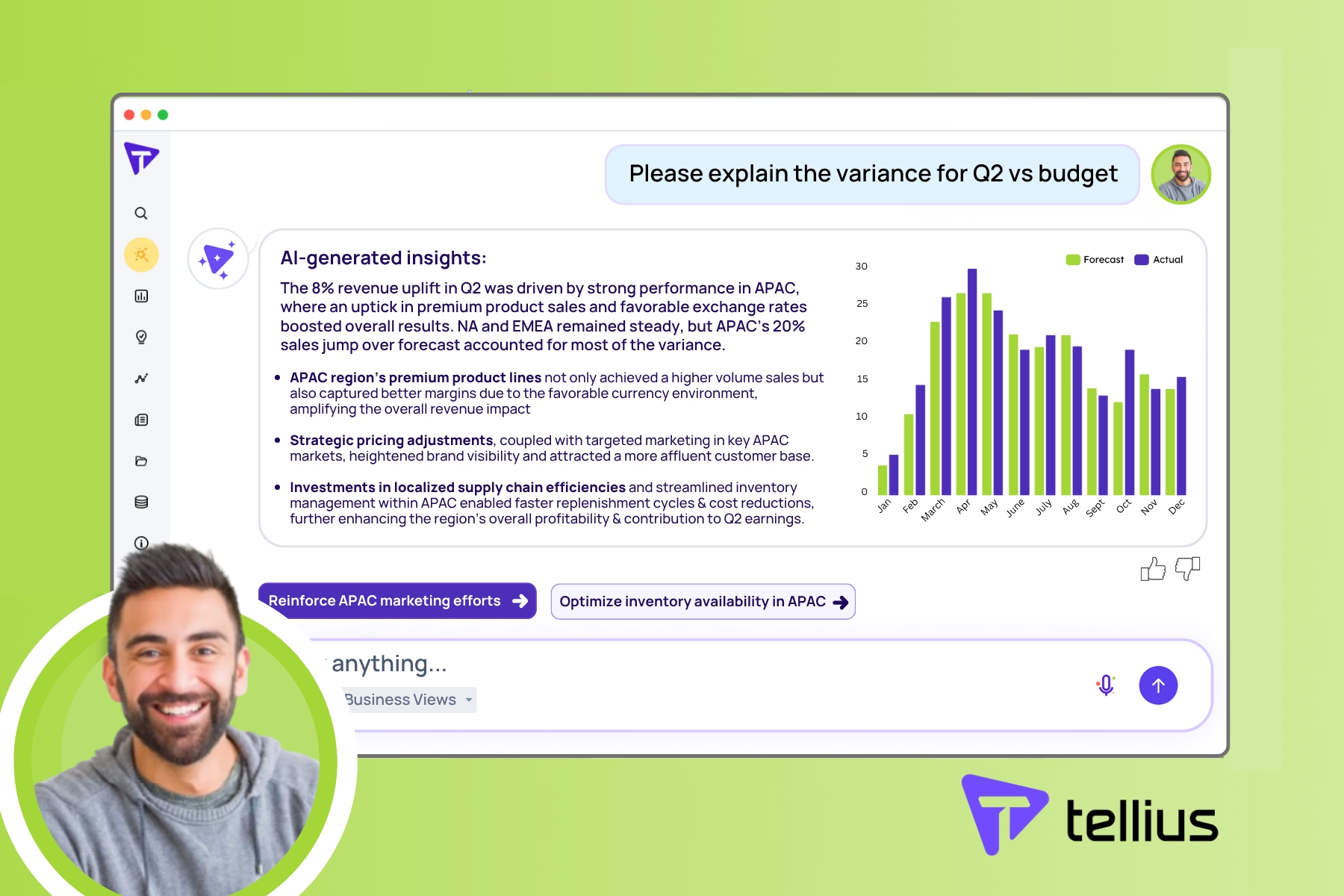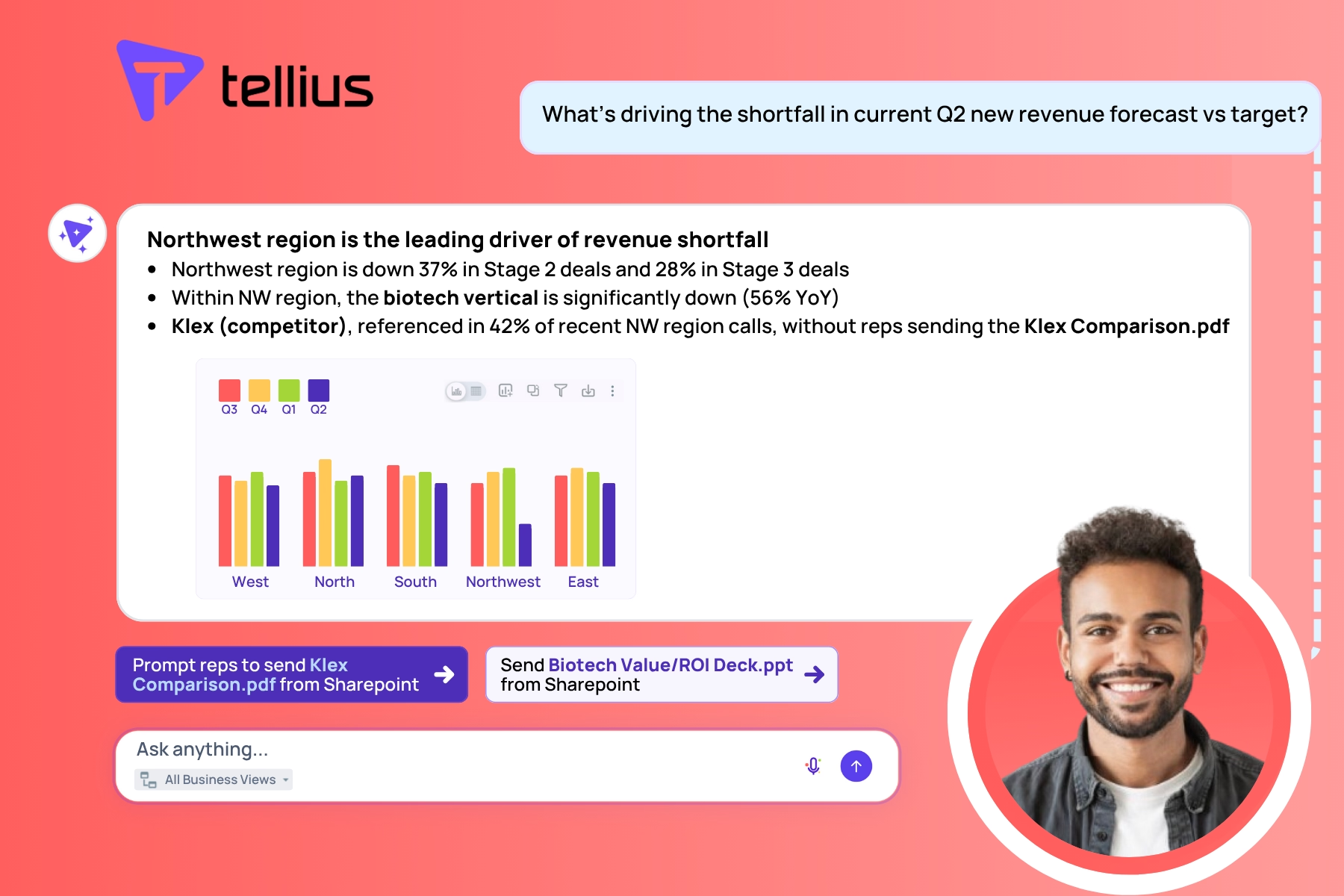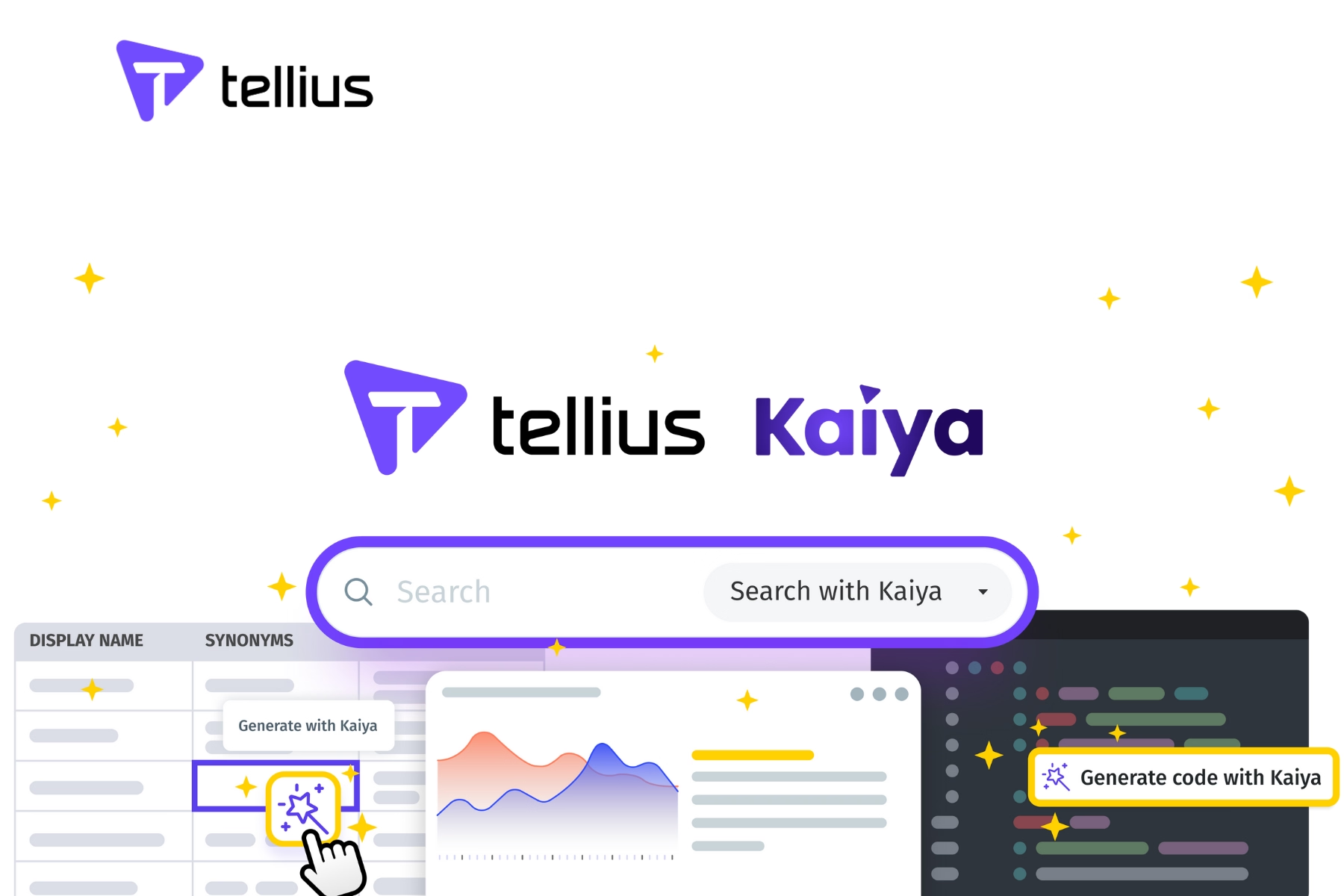How Novo Nordisk Unlocks Pharma Commercial Ops Efficiencies with AI Analytics

Novo Nordisk’s Director of Field Systems, Frank Armenante, recently shared his experience leveraging Tellius’ AI-powered analytics for commercial pharma effectiveness in a webinar with our friends at PMSA. This blog summarizes his story, including the practical tips, use cases, and best practices he shared that can help other pharma field, home office, and analytics leaders in their AI journey. His story describes the spark that began the journey, initial challenges, and eventual triumph, ultimately illustrating how embracing new technologies can drive business operation efficiency. Let’s begin! 📖
The spark of curiosity
It all began with a simple conversation in summer 2023. The buzz around generative AI—fueled by advancements from OpenAI and Microsoft—and the potential productivity gains piqued the interest of Novo Nordisk’s team. Frank and his IT counterpart, Sanjeev, decided to explore the potential of AI to enhance their field operations. This curiosity led them to Tellius.
“There was a lot of noise, but at the end of the day, we had high hopes AI could save us time and help us build the business. Plus it would fit in nicely with Novo Nordisk’s ethos of innovation,” said Frank.
The challenge/opportunity/status quo
Novo Nordisk’s commercial analytics team was curious if AI could help solve a real problem: the insatiable appetite for data-driven answers and insights, due to the firm’s rapid growth in product success and data volumes in the last few years.
Specifically, Frank’s customers—the field leadership, commercial execution teams, and home office teams for numerous brands—were looking to Frank’s team for actionable insights derived from mountains of data at increasingly faster rates to capture market opportunities.
Commercial execution teams, for example, needed to know which healthcare professionals (HCPs) to target. Field leadership needed to optimize field team performance by aligning territories and adjusting sales strategy based on data. Home office teams needed to swiftly identify market-impacted trends and changes related to competitors, market access changes, and regulations. Unfortunately, with the current approach to analytics, they were struggling to keep up with this massive demand, and opportunities were passing by.
Frank pinpointed the real culprit: a lack of analytics flexibility. A typical dashboard took 6-12 weeks to develop, involving gathering requirements, identifying and integrating data sources, data modeling and prep, dashboard design and development, testing and validation, and multiple cycles of iteration. People needed answers and insights more quickly, and in a more open-ended way.
Tellius’ AI-powered search and insights platform seemed promising. Natural language querying could unlock self-service to the many requests from the business by allowing teams to answer their own questions on billions of rows of internal and external datasets from places like IQVIA. AI-powered automated insights and a highly flexible way to perform advanced analytics could supercharge analysts, helping them work smarter and faster.
Frank and Sajeev rapidly integrated Tellius into their analytics stack.
The bumpy road
But the path to innovation was bumpy.
After a quick rollout of Tellius, Frank was met with resistance from users accustomed to traditional dashboarding and reporting tools. Users expected to scan for metrics in dashboards, not search for them. Many were reluctant to change habits. Some didn’t even log in.
Frank feared his vision of boosting sales effectiveness through AI-powered self-serve answers and insights was at risk of failing.
“We were really at the point where some people just didn't know how to use the tool,” Frank admitted.
The team realized they needed a different approach.
The turning point
The key was positioning and targeting the right users. They started by positioning Tellius as a sister tool for ad hoc analysis and self-service analytics alongside existing dashboards and reporting capabilities, which helped clarify when to use the tool, resulting in more openness to trying it. Next, they targeted users with a natural curiosity and passion for data. Finally, they provided targeted training and support, including weekly sessions where users could ask questions and receive guidance.
This shift in strategy paid off. Users began to see the value of the new tool, and they began to realize the power of flexible, rapid ad hoc answers and complex diagnostic analytics made easy.
“We still do weekly sessions where anybody can jump in and start messing around with it, and we have experts on the line who can help them out with that. It changed everything. It really did,” Frank shared.
Another crucial element of their new approach was to foster better alignment among IT, finance, and the business teams and their goals. Continuous communication and collaboration ensured that both teams were supportive of the new initiatives. This collaboration was key to overcoming the initial resistance and achieving much wider adoption of the new tool.
“You have to gain alignment early on, which we have,” explained Frank. “And we've been showing them how we've been successful with this. We just did a video from the business, IT, and my team that we shared with our senior leadership on why we've had success here and why this is different from some of the other AI projects that we've been able to do.”
The impact
The impact of the AI-powered analytics platform was profound.
Thanks to the focus on three initial use cases—that were clearly scoped and had defined success metrics—there has been considerable time-savings and business growth across Novo Nordisk’s home office, commercial execution, and field leadership teams. Those three use cases were 1) self-service analytics; 2) AI-augmented strategic business planning; and 3) diagnostic performance driver identification.
Frank relayed the story of how one of Novo Nordisk’s sales leaders in the Western U.S. uses Tellius for all his business reviews by creating views of the data for each person, which dynamically changes with shifting market conditions. Then, they can easily share a link to key findings and insights to anyone in the business. This short-circuits the previously lengthy dashboard building process, translating to several hours of this leader’s time saved.
One standout success was the reduction in time spent on data analysis and report generation. Tasks that previously took hours were completed in minutes.
“One power user told me he went from an analytics process taking him four hours down to about 10 minutes,” Frank explained.
This newfound efficiency has allowed users to focus on more strategic activities, significantly enhancing their productivity.
As the adoption of AI-powered analytics grew, so did the benefits. Frank highlighted the considerable return on investment (ROI) achievable through incremental improvements in business operations.
“If we can incrementally grow business one percent for every single person that's out there, doing the math over 3,000 people for 12 months, it’s a considerable return on investment,” he noted.
Top lessons from Frank's story
We've rounded up nine best practices for rolling out AI-powered analytics, based on Frank’s experience:
- Select Passionate Users. Choose users who are enthusiastic about learning and exploring new tools.
- Provide Proper Training. Offer continuous training and support to build user confidence and proficiency.
- Emphasize Practical Benefits. Highlight real-world improvements in efficiency and productivity within the business and more broadly.
- Align Goals. Ensure effective communication and collaboration between IT, finance, and business teams.
- Adopt a Flexible and Incremental Approach. Start with a pilot program and make iterative improvements based on feedback.
- Understand and Define the Process. Clearly define goals and processes before implementation.
- Focus on Change Management. Provide comprehensive training materials and support for smooth adoption.
- Involve the Right Stakeholders Early. Engage key stakeholders from the beginning to secure support and resources.
- Iterate and Improve Based on Feedback. Be open to feedback and be willing to make necessary adjustments.
Conclusion
Frank's story of transformation at Novo Nordisk is a testament to the power of curiosity, perseverance, and strategic change management. By embracing AI-powered analytics, the company overcame significant analytics bottlenecks and inflexibility and unlocked new opportunities for growth and efficiency. The journey, marked by initial struggles and eventual triumphs, offers valuable lessons for any pharmaceutical firm looking to harness the potential of AI to drive business success.
Tellius helps organizations unlock answers and insights from all their data using AI. Learn more about how we leverage AI to specifically help commercial pharma teams hit quota and gain market share here, or book a personalized demo for a product walkthrough. 💊🚀
Get release updates delivered straight to your inbox.
No spam—we hate it as much as you do!


How AI Variance Analysis Transforms FP&A

Learn how AI-powered variance analysis is transforming how organizations uncover and act upon financial insights.

RevOps Intelligence Redefined: AI-Powered Agents Meet Unified Knowledge Layer

Learn how AI-powered variance analysis is transforming how organizations uncover and act upon financial insights.

Tellius Kaiya: Welcome to the Next Generation of Self-Service

Introducing Tellius Kaiya: A suite of GenAI-powered tools designed to democratize data-driven decision-making for the entire organization.

